At Jamaica Bay a couple of weeks ago I was lucky enough to be with birders who carefully scan through each and every bird in a flock hoping to find a rarity. Not that I don’t do that, but I tend to get distracted by whatever bird happens to be closest and in good light so I am usually taking a picture of a Common Tern or a juvenile Least Sandpiper when someone says “I have a [insert pretty darn good bird of your choice] here.”
I am not sure if my behavior makes me like a parasite, in that I attach to a host and suck the rarities from them, like a sidekick in that someone else finds the rare bird and I get pictures and serve as back up in case some other birder questions the sighting and say things like “Great Audubon’s Ghost! That’s one heck of a bird!” or, perhaps, like a jaeger, in that I let someone else do the work and then harass them until they disgorge the rarity into my optics, but I do know that I either lack the patience or skill (or both?) to scan through big flocks of shorebirds and find the good one.* I do, on occasion, find the shorebird that is slightly different but not different enough, like an injured dowitcher, a knot with a tumor, or a sandpiper that managed to dip itself into some oil.
Anyway, to get us back to the topic at hand here, last week one of the several birders I was with said something like “There’s a Long-billed Dowitcher up ahead.”
Now, Long-billed Dowitchers aren’t particularly rare, though there are probably a couple hundred Short-billed Dowitchers for every Long-billed Dowitcher that goes through Jamaica Bay, but they are very similar to Short-billed Dowitchers so they are difficult to pick out of the flock. In this case we were lucky in that the bird was feeding with just a few other birds so once one of my fellow birders had identified it there was no problem keeping up with its location.
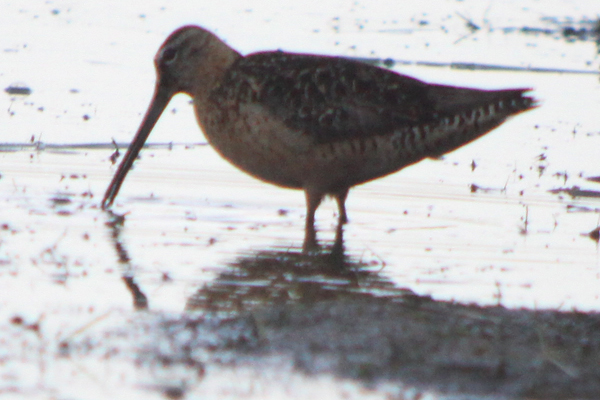 Unfortunately, the bird was in bad light and kind of distant. So we took record shots (one is over there on the left), and, because we figured that we had to walk towards and past it anyway, we might as well make our move in a slow and steady way that might, instead of flushing the dowitcher altogether, get it to move gradually into better light as we drew closer. So we slowly and carefully made our way north along the east edge of the pond, a good spot to move slowly anyway because of the nasty mud, and, sure enough, the bird cooperated by walking into much better light just as we started to get relatively close to it. Score one for the birders!
Unfortunately, the bird was in bad light and kind of distant. So we took record shots (one is over there on the left), and, because we figured that we had to walk towards and past it anyway, we might as well make our move in a slow and steady way that might, instead of flushing the dowitcher altogether, get it to move gradually into better light as we drew closer. So we slowly and carefully made our way north along the east edge of the pond, a good spot to move slowly anyway because of the nasty mud, and, sure enough, the bird cooperated by walking into much better light just as we started to get relatively close to it. Score one for the birders!
Long-billed Dowitcher above and the same bird with a juvenile Short-billed Dowitcher below.
So what made this particular bird Limnodromus scolopaceus rather than Limnodromus griseus? Ha! How about because I said so? Or how about we have a contest to see who can pronounce dowitcher scientific names quickly and correctly? Or, hey, look over there, it’s a Spoon-billed Sandpiper!
[footsteps footsteps footsteps…door slam]
The picture above was taken seconds before the picture below.
Seriously though, if you want to learn the difference between the dowitchers** I highly recommend you do something easier, like getting a camel through the eye of a needle, identifying silent Empidonax flycatchers, or explaining to a teabagger that Barack Obama can’t be a practicing Muslim, a Communist, and a Nazi at the same time. In the meantime, enjoy these last two pictures of the Long-billed Dowitcher with a Greater Yellowlegs, a bird from which you should have no problem distinguishing the Long-billed Dowitcher.
…
*The exceptions to this rule are as follows: 1. When the bird in question is really, really, obvious, like an avocet among dowitchers or a godwit among peeps. 2. When I am the only birder there and know that something really, really, good has been reported I will buckle down and do the work. 3. When a rare but cryptic shorebird crashes into my head and falls at my feet, but only if it is also wearing a sign identifying itself.
**I have been told that they are readily identifiable by taste, so maybe you just need to grab one and lick it? Good luck with that. Though, if you do lick a dowitcher at Jamaica Bay’s East Pond and accidentally ingest some mud you might end up hallucinating.


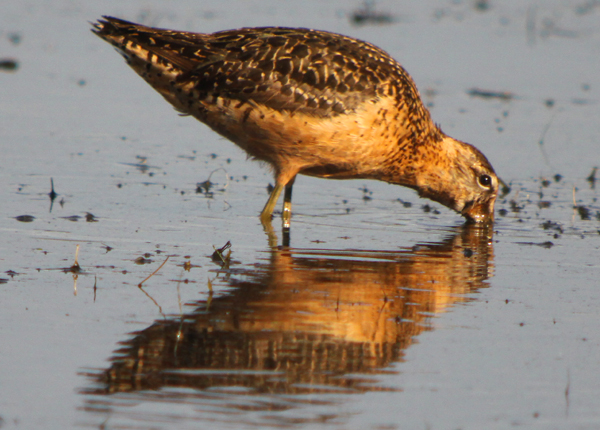
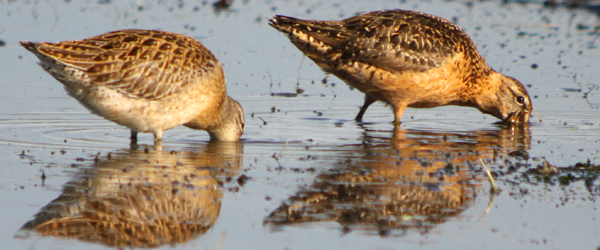
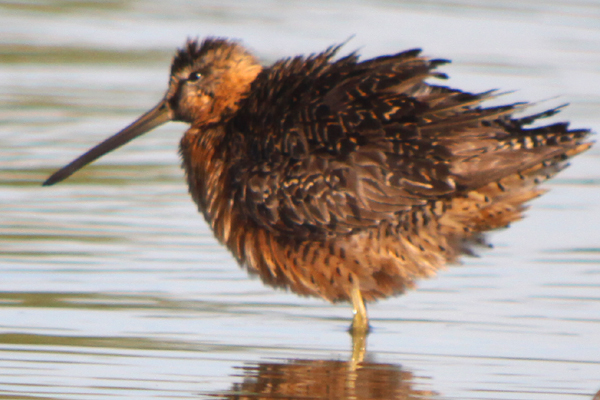
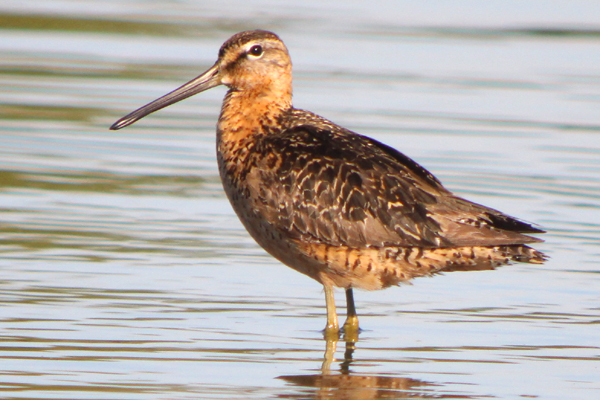
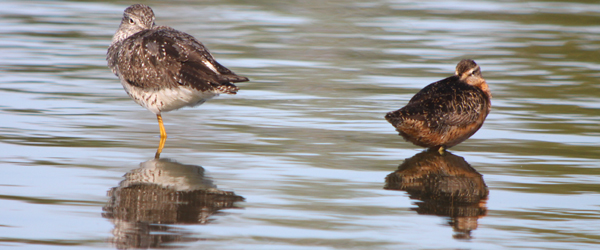
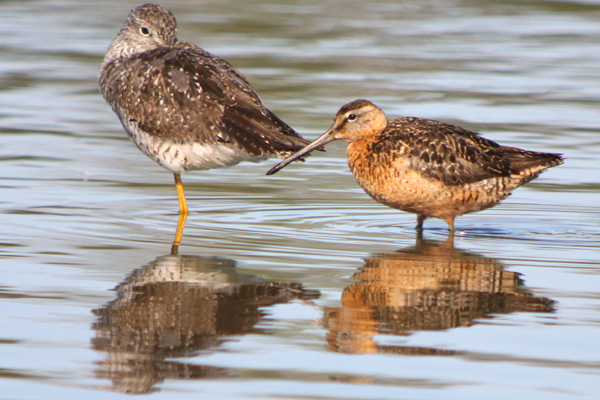











Love this post 😉 but ah, L.g. griseus from L. Scolopaceous is one thing, but L.g. hendersoni from L. Scolopaceous…now then…and there seems to be crazy variation among L.g. susbspecies as well… I have had my head immersed in this for two weeks now, and am convinced that a lifetime would not be enough – all I can say is that I have gratitude that there are “obvious” ones in the mix and then – oh look, a Spoon-billed Sandpiper…
typo: Scolopaceus not Scolopaceous.
Not to question the ID, but more for our education, how do weseparate this Long-billed from a hendersoni Short-billed? See page 204, photo 10 in The Shorebird Guide. I’m not trying to put you on the spot, Corey, but I’m hoping a reader can comment.
Arguments for L. scolopaceus over L.g. hendersoni *in these photos* (caveat) and *in general* (from a non expert):
Spots and barring along sides of L.g. hendersoni tend to be more regular in distribution; the neck barring on L. scolopaceus tends to be denser. This photo shows a nice break in patterning, with heavy darks around the neck. Hendersoni also tend to be a bit brighter on the upperparts, this bird has the dark look of scolopaceus.
Things missing from the photos: structure differences (can’t really compare with the griseus for that, because the griseus is so heavily foreshortened) and views of potential differences in tails.
Did I miss anything glaring? Feedback from someone who actually knows what they are talking about?
Also (sorry so many comments, getting offline NOW): structure *looks* quite heavy-chested/chunky ala Long-billed – but I’m always highly distrustful of photos in these matters…
Is it “heavy” enough to be a “fat bastard” as Richard Crossley has been known to say? (Say it with a British accent) I agree that it’s a tough call on structure based on the photos. I think you make some good points on plumage though.
@Birdspot and Patrick: I’ve been away from the computer all day and don’t have time to really get deep into it right now but will say that this bird was a hulking beast of a dowitcher. That, the fact that better birders than I told me what it was let me ID it for sure, and the icing on the cake was that it called once.
If I manage to get good enough shots I hope to do a comparison post between L. g. hendersoni and L. scolopaceus soon, that is, if I can come to fully understand the differences myself.
“Hulking beast” and “fat bastard” have me laughing! Great to see the photos, Corey – they look solidly Long-billed to me. I’m having great geeky fun working through writing out the differences, and trying to apply them to your photos (oh look, a butterfly) 😉
Okay, I’d first like to state that I have a scientific education and usually prefer to “know” rather than to “feel”. Having said that, I once read an article on Surfbirds about dowitcher separation and the authors presented the base of the bill as a good field mark: broadened at the base in Shorty (almost like a mini funnel stuck onto the bird’s forehead) and not so in Long-billed. To my amazemend (no, there did not stand a raven whose shadow hung above my door, in case fans of APP are reading this) this worked and works quite well for me as it gives the two species a remarkably different “feel”. In other words, the whole facial expression -that primates are trained to focus on- is a completely different one. I have tested it with numerous pictures on the I’Net and got the species separated correctly in 100% of all cases, regardless of plumage.
So I am happy to confirm with certainty that this is a Short-billed …
Kidding. No, it absolutely fits the “feel” of a Long-billed.
And regarding hendersoni and griseus: In May 2005 I had a very nice day at Ontario’s Hilman Marsh, with numerous shorebirds present. Amongst the many hendersoni-Shorties were two birds that looked almost like non-breeding birds, they stood out like an ostrich within a flock of Bee Hummingbirds, and were clearly breeding-plumage griseus. If one gets into the details, like birdspot (wow!), one will surely find difficult birds and maybe even integrates, but it seems to me that the odd bird of one form within a large flock of the other would be easy to pick out.
Cheers!
@Jochen – thanks for that! I have been immersed in skins – pros and cons galore – I was looking for that “facial feel” as per the Surfbirds article, which, when I read it, also sent me to look through a gazillion photos, but because they are skins, facial expression is unreliable (more or less cotton stuffing, some of them look quite bizarre). But bills are static! Maybe I’ll do drawings of bill differences, specifically to look at the bases…there’s also a definite change in shape in the bill, with Short-billed having a different top slope/gonydeal angle/tip.
The thing that surprised me: from the sample of L. griseus skins (lots and lots): the hendersoni and griseus are more often confusing and not “typical” than they are easily identifiable, as to plumage variation. This is not a field observation, just from the sample I have been working with. I would have assumed the opposite, like what you observed: I assumed that the ones that appeared “typical” would outnumber those that appeared mixed/contrary, but in the ones I have seen, they do not! For whatever that is worth; the reasons could be myriad. It’s confusing to me, and I’ll leave it to those with dissertations on the subject. 😉
Catherine
@Catherine: oh, it’s up to me to thank you!
I have never really worked with skins, which I sense might be both a shame and a blessing. Most of my identifications are initiated by a “wild guess” based on gestalt, facial expression etc. that is later – hopefully – confirmed by checking for more earthly field characters, and I would surely feel very lost and small in front of a museum skin.
And I think “top slope/gonydeal angle/tip” just entered my “birding term” charts at No. 1 …
About the two Ontario birds: I am from Germany and was there on a short birding trip, so most of the shorebirds in front of me were new and the proximity to Point Pelee’s warblers also didn’t help in pushing me to spend a whole lot of time studying dowitcher variation. However, I clearly remember these two birds, they were amongst the first dowitchers I saw that day, and I consequently did look at the variation of the others. Well, amongst that one particular flock, there was limited variation amongst the hendersoni, some were darker while some were paler, but then there was a clear gap and finally there was the griseus duo.
I therefore tend to claim the “duo” as being griseus, which are not unusual at the location in small numbers. However, if challenged I’d certainly refrain from arguing my point.
Yupp, I agree: let others do the “dirty” work. All we have to do then is read their papers and go out and find the birds they have sorted out for us, exclaiming that we knew it all along!
🙂
Cheers and happy birding!!
Jochen
Cheers and happy birding to you – switching to passerines now! C